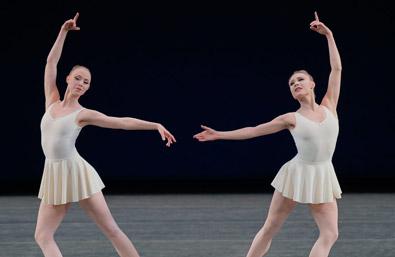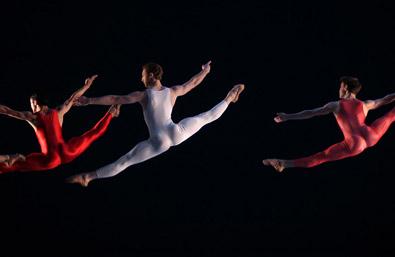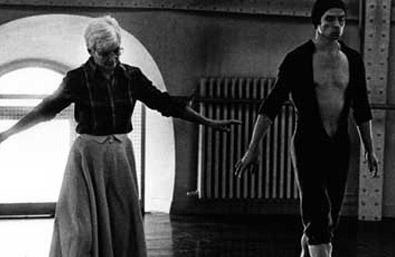Bach and dance
The session will feature three ballets by three great choreographers of the 20th century: Balanchine, Spoerli and Nureyev, with music by J.S. Bach. They will be presented and commented by Roger Salas, curator of the Coda en movimiento cycle.
Free admission. Invitations may be collected at the Museum's ticket office.
BAROQUE CONCERTO (GEORGE BALANCHINE)
Choreography: George Balanchine
Music: Johann Sebastian Bach, Concerto in D minor for Two Violins BWV 1043
Premiere: 1941
Duration: 18 minutes
 Balanchine said of this work: "If the dance designer sees in the development of classical dance a counterpart to the development of music and has studied them both, he or she will draw continuous inspiration from great scores.".
Balanchine said of this work: "If the dance designer sees in the development of classical dance a counterpart to the development of music and has studied them both, he or she will draw continuous inspiration from great scores.".
In the first movement of the concerto, two dancers embody violins while accompanied by a corps de ballet of eight dancers. In the second movement, a largo, the dancer joins the principal dancer in a pas de deux. In the last section, allegro, the entire ensemble expresses the rhythmic, syncopated vitality of Bach's music.
The work began as an exercise by Balanchine for the School of American Ballet and was performed by the American Ballet Caravan on its historic tour of South America in 1941. When it was integrated into the repertory of the Ballet Russe de Monte Carlo in 1945, Balanchine dressed the dancers in more practical costumes in what was probably the first appearance of what has come to be regarded as Balanchine's signature modern ballet costumes. In 1948, Concerto Barrocco was one of three ballets included in the program of New York City Ballet's first performance.
GOLDBERG VARIATIONS (HEINZ SPOERLI)
Choreography: Heinz Spoerli
Music: Johann Sebastian Bach, Goldberg Variations BWV 988
Premiere: 1993
Company: Zurich Ballet
 The Goldberg Variations by Spoerli are an abstract and choral work of modern ballet. They were originally created in 1993 for the Deutsche Oper am Rhein (Düsseldorf) with designs by the Dutch Kekso Dekker and have been part of the repertoire of the Zurich Ballet since 1996.
The Goldberg Variations by Spoerli are an abstract and choral work of modern ballet. They were originally created in 1993 for the Deutsche Oper am Rhein (Düsseldorf) with designs by the Dutch Kekso Dekker and have been part of the repertoire of the Zurich Ballet since 1996.
The work uses in its entirety the score completed by Johann Sebastian Bach in 1742 in Leipzig almost at the end of his career and the Swiss is the only choreographer who has embarked on the adventure of bringing the entire work to dance, although it had previously been used partially by other choreographers. In Spoerli's Goldberg Variations the challenge is embodied in the transfer to the danced images of the contrapuntal complexity of the musical work.
SUITE No. 3 BY BACH (NUREYEV)
Choreography: Rudolf Nureyev in collaboration with Francine Lancelot
Music: Johann Sebastian Bach, Suite No. 3 in C Major for Solo Cello BWV 1009
Premiere: 1984
Company: Ballet de l'Opera de Paris
 Nureyev arrived at the Paris Opera Ballet in 1983 and asked Francine Lancelot, an expert dancer in ancient, especially baroque, and traditional dance, to prepare a ballet solo for him with Suite n.3 by Bach, his favorite musician.
Nureyev arrived at the Paris Opera Ballet in 1983 and asked Francine Lancelot, an expert dancer in ancient, especially baroque, and traditional dance, to prepare a ballet solo for him with Suite n.3 by Bach, his favorite musician.
Francine Lancelot was inspired by the piece Bach Suite from the dance manual written by Pierre Rameau (1674 - 1748), where the ballet master and theorist explains in detail how to execute steps from some forty dances from the time of Louis XIV for court dances and opera ballets.
From Lancelot's work, Rudolf Nureyev participated in the elaboration of the choreography, developing the baroque character or moving away from it, depending on his own inspiration.
"I am amazed at the way, working by imitation and without notation, Nureyev assimilates such complicated chaining. He acquired the natural arm movements and sense of gesture instinctively. If I show him that the ornamentation is correct before the note, he understands and reacts instantly. After only a few rehearsals, he has practically abandoned force in favor of grace." Thus Francine Lancelot described Nureyev's work in an article quoted in Rudolf Nureyev in Paris, the program book designed by the staff of the Paris Opera and published by La Martinière on the occasion of the gala held on January 20, 2003 at the Palais Garnier to celebrate the tenth anniversary of the choreographer's death.
Date
February 16, 2017
Time
19:00